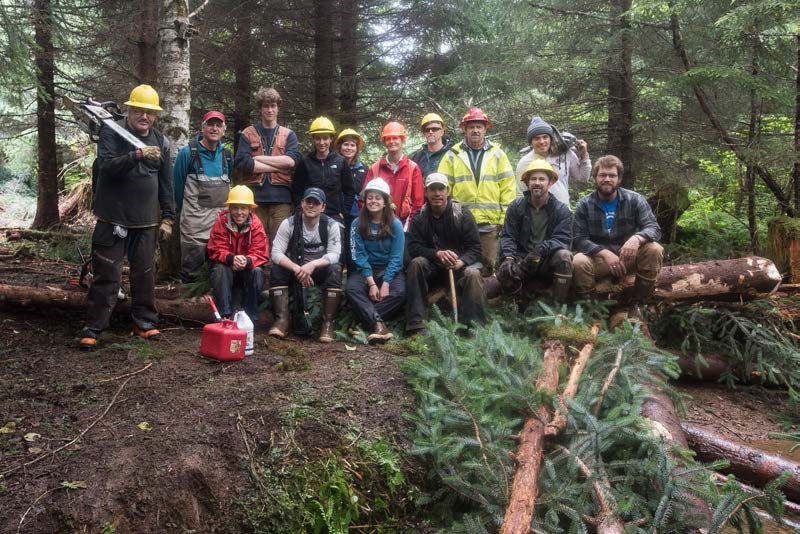
Purpose of the project: The Hoonah Native Forest Partnership (HNFP) aims to balance ecological social and economic outcomes by employing an interdisciplinary collaborative approach to watershed assessment and resource planning. Using a science-based, landscape scale, community forest approach to sustainable watershed management, the HNFP works across land ownership boundaries to achieve a measurable and resilient blend of timber, salmon, deer, and other forest products that maintain and improve resource conditions for landowners and local residents. The project area is located in Northern Chichigof Island in Southeast Alaska and is located near the community of Hoonah. It is part of the world’s largest coastal temperate rainforest and supports a variety of fish and wildlife that are critical for the livelihood, culture, and traditions of the Huna Tlingit tribe and local residents.
Purpose of the project:
The Hoonah Native Forest Partnership (HNFP) aims to balance ecological social and economic outcomes by employing an interdisciplinary collaborative approach to watershed assessment and resource planning. Using a science-based, landscape scale, community forest approach to sustainable watershed management, the HNFP works across land ownership boundaries to achieve a measurable and resilient blend of timber, salmon, deer, and other forest products that maintain and improve resource conditions for landowners and residents. The project area is located in Northern Chichigof Island in Southeast Alaska and is located near the community of Hoonah. It is part of the world’s largest coastal temperate rainforest and supports a variety of fish and wildlife that are critical for the livelihood, culture, and traditions of the Huna Tlingit tribe and residents.
Spasski River Watershed is a priority area to the HNFP and a priority watershed to the Tongass National Forest. This 20,673-acre watershed is managed by Huna Totem Corporation (47%) and the Tongass National Forest (53%). It is valuable to residents of Hoonah for fish, deer, timber, and other resources. It is a densely roaded watershed with extensively harvested valley bottoms and hillslopes that have altered streams and habitats.
Watershed restoration by the Hoonah Native Forest Partnership includes numerous restoration opportunities in the Spasski River Watershed and includes stream habitat restoration, riparian area vegetation treatments for stream resilience and wildlife habitats improvements, fish passage improvements across roads, sediment reduction from roads and forest thinning treatments for restoration and forest products. Assessment and planning by the Hoonah Native Forest Partnership began in 2015 and pilot projects in the Spasski River Watershed initiated in 2018 and will continue through 2023. It is envisioned these obtainable restoration opportunities will improve the watershed condition and provide local jobs and economic stimulus to the rural Alaskan community of Hoonah.
Human Interest/Community Benefit: The Spasski River Watershed assessment and restoration plan have been guided by community values and landowner agreements. A local workforce has been established that has become skilled in natural resource data collection, management, and project implementation. The actions ongoing in Spasski Watershed are restoring healthy fish and wildlife habitats, diversifying the local economy and building sustainable, and locally-led, land management.
Project partners have created many platforms for sharing information on the Hoonah Native Forest Partnership and efforts of the project.
Project Resources:
http://sustainablesoutheast.net/hoonah-native-forest-partnership/
https://www.facebook.com/hoonahnativeforestparternship
https://www.hia-env.org/hoonah-native-forest-partnership/
In addition, a short video was created to help share an overview of the project and highlight the work of field crew: http://bit.ly/2Z8m5j6
Also, in March of 2018, project partners shared an overview of collaborative lessons learned from this project: http://bit.ly/30Flfek
Project Timeline:
• 2015-2016 Data collection including community outreach and subsistence surveys, media outreach, resource data collection including fish, wildlife, vegetation, and roads.
• 2017-Data assessment, sharing of results and shareholder input
• 2018 Watershed Assessment and Pilot Projects
• 2019 Restoration Plan and Project Implementation
• 2020-2023 Restoration and Monitoring
Economic impact models have been developed to track the expenditures made in local communities and estimate the local economic activity generated as a result of expenditures made from restoration projects. Model results specific to the Spasski Watershed Project, including expenditures for pre-project assessment and planning that occurred in 2015 and 2016, and direct project expenditures made in 2017-2019, show an investment of $630,000 (not including other in-kind project support) supports 11.8 jobs in Hoonah and generates roughly $1,130,000 in total sales, $630,000 in value-added and
$520,000 in incomes for this local community.
Partners: Huna Totem Corporation, Sealaska Corporation, The Nature Conservancy, Tongass National Forest, Southeast Sustainable Partnership, Alaska Fish and Game, Hoonah Indian Association, Fish and Wildlife Service, Natural Resource Conservation Service
